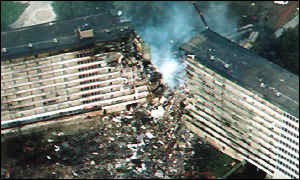Again, I hate to burst your bubble but a book written by a philosopher is probably not the best source on matters involving metallurgy, architecture, physics, etc.
This is the letter by Dr. Barnett published in JOM by the The Minerals, Metals, and Materials Society that your post referred to:
ANALYSIS
Rapid deterioration of the steel was a result of heating with oxidation in combination with intergranular melting due to the presence of sulfur. The formation of the eutectic mixture of iron oxide and iron sulfide lowers the temperature at which liquid can form in this steel. This strongly suggests that the temperatures in this region of the steel beam approached ~1,000ºC, forming the eutectic liquid by a process similar to making a “blacksmith’s weld” in a hand forge.
http://www.tms.org/pubs/journals/JOM/0112/Biederman/Biederman-0112.htmlAnd here is the rest of the "greatest mystery statement"
The New York Times called these findings "perhaps the deepest mystery uncovered in the investigation." The significance of the work on a sample from Building 7 and a structural column from one of the twin towers becomes apparent only when one sees these heavy chunks of damaged metal.
A one-inch column has been reduced to half-inch thickness. Its edges--which are curled like a paper scroll--have been thinned to almost razor sharpness. Gaping holes--some larger than a silver dollar--let light shine through a formerly solid steel flange. This Swiss cheese appearance shocked all of the fire-wise professors, who expected to see distortion and bending--but not holes.
A eutectic compound is a mixture of two or more substances that melts at the lowest temperature of any mixture of its components. Blacksmiths took advantage of this property by welding over fires of sulfur-rich charcoal, which lowers the melting point of iron. In the World Trade Center fire, the presence of oxygen, sulfur and heat caused iron oxide and iron sulfide to form at the surface of structural steel members. This liquid slag corroded through intergranular channels into the body of the metal, causing severe erosion and a loss of structural integrity.
"The important questions," says Biederman, "are how much sulfur do you need, and where did it come from? The answer could be as simple--and this is scary- as acid rain."
Have environmental pollutants increased the potential for eutectic reactions? "We may have just the inherent conditions in the atmosphere so that a lot of water on a burning building will form sulfuric acid, hydrogen sulfide or hydroxides, and start the eutectic process as the steel heats up," Biederman says. He notes that the sulfur could also have come from contents of the burning buildings, such as rubber or plastics. Another possible culprit is ocean salts, such as sodium sulfate, which is known to catalyze sulfidation reactions on turbine blades of jet engines. "All of these things have to be explored," he says.
http://www.wpi.edu/News/Transformations/2002Spring/steel.htmlSo the authors suggest acid rain as a cause of the lowered melting point of steel...no mention of bombs. Clearly, the debunking book takes these comments out of context.
Another article, "Why Did the World Trade Center Collapse? Science, Engineering, and Speculation" by Thomas W. Eagar and Christopher Musso of MIT, from the same issue of JOM. There are many points in this article, some highlights:
While the aircraft impact undoubtedly destroyed several columns in the WTC perimeter wall, the number of columns lost on the initial impact was not large and the loads were shifted to remaining columns in this highly redundant structure. Of equal or even greater significance during this initial impact was the explosion when 90,000 L gallons of jet fuel, comprising nearly 1/3 of the aircraft’s weight, ignited. The ensuing fire was clearly the principal cause of the collapse.
The fire is the most misunderstood part of the WTC collapse. Even today, the media report (and many scientists believe) that the steel melted. It is argued that the jet fuel burns very hot, especially with so much fuel present. This is not true.
Part of the problem is that people (including engineers) often confuse temperature and heat. While they are related, they are not the same. Thermodynamically, the heat contained in a material is related to the temperature through the heat capacity and the density (or mass). Temperature is defined as an intensive property, meaning that it does not vary with the quantity of material, while the heat is an extensive property, which does vary with the amount of material. One way to distinguish the two is to note that if a second log is added to the fireplace, the temperature does not double; it stays roughly the same, but the size of the fire or the length of time the fire burns, or a combination of the two, doubles. Thus, the fact that there were 90,000 L of jet fuel on a few floors of the WTC does not mean that this was an unusually hot fire. The temperature of the fire at the WTC was not unusual, and it was most definitely not capable of melting steel.
Some reports suggest that the aluminum from the aircraft ignited, creating very high temperatures. While it is possible to ignite aluminum under special conditions, such conditions are not commonly attained in a hydrocarbon-based diffuse flame. In addition, the flame would be white hot, like a giant sparkler. There was no evidence of such aluminum ignition, which would have been visible even through the dense soot.
It is known that structural steel begins to soften around 425°C and loses about half of its strength at 650°C.4 This is why steel is stress relieved in this temperature range. But even a 50% loss of strength is still insufficient, by itself, to explain the WTC collapse. It was noted above that the wind load controlled the design allowables. The WTC, on this low-wind day, was likely not stressed more than a third of the design allowable, which is roughly one-fifth of the yield strength of the steel. Even with its strength halved, the steel could still support two to three times the stresses imposed by a 650°C fire.
The additional problem was distortion of the steel in the fire. The temperature of the fire was not uniform everywhere, and the temperature on the outside of the box columns was clearly lower than on the side facing the fire. The temperature along the 18 m long joists was certainly not uniform. Given the thermal expansion of steel, a 150°C temperature difference from one location to another will produce yield-level residual stresses. This produced distortions in the slender structural steel, which resulted in buckling failures. Thus, the failure of the steel was due to two factors: loss of strength due to the temperature of the fire, and loss of structural integrity due to distortion of the steel from the non-uniform temperatures in the fire.
The perimeter tube design of the WTC was highly redundant. It survived the loss of several exterior columns due to aircraft impact, but the ensuing fire led to other steel failures. Many structural engineers believe that the weak points—the limiting factors on design allowables—were the angle clips that held the floor joists between the columns on the perimeter wall and the core structure (see Figure 5). With a 700 Pa floor design allowable, each floor should have been able to support approximately 1,300 t beyond its own weight. The total weight of each tower was about 500,000 t.
As the joists on one or two of the most heavily burned floors gave way and the outer box columns began to bow outward, the floors above them also fell. The floor below (with its 1,300 t design capacity) could not support the roughly 45,000 t of ten floors (or more) above crashing down on these angle clips. This started the domino effect that caused the buildings to collapse within ten seconds, hitting bottom with an estimated speed of 200 km per hour. If it had been free fall, with no restraint, the collapse would have only taken eight seconds and would have impacted at 300 km/h.1 It has been suggested that it was fortunate that the WTC did not tip over onto other buildings surrounding the area. There are several points that should be made. First, the building is not solid; it is 95 percent air and, hence, can implode onto itself. Second, there is no lateral load, even the impact of a speeding aircraft, which is sufficient to move the center of gravity one hundred feet to the side such that it is not within the base footprint of the structure. Third, given the near free-fall collapse, there was insufficient time for portions to attain significant lateral velocity. To summarize all of these points, a 500,000 t structure has too much inertia to fall in any direction other than nearly straight down.
http://www.tms.org/pubs/journals/JOM/0112/Eagar/Eagar-0112.htmlCliff Stryker Buck, Ph.D.
Department of Oceanography
Florida State University












